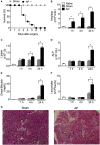Antibiotic-Induced Pathobiont Dissemination Accelerates Mortality in Severe Experimental Pancreatitis
- PMID: 29375557
- PMCID: PMC5770733
- DOI: 10.3389/fimmu.2017.01890
Antibiotic-Induced Pathobiont Dissemination Accelerates Mortality in Severe Experimental Pancreatitis
Abstract
Although antibiotic-induced dysbiosis has been demonstrated to exacerbate intestinal inflammation, it has been suggested that antibiotic prophylaxis may be beneficial in certain clinical conditions such as acute pancreatitis (AP). However, whether broad-spectrum antibiotics, such as meropenem, influence the dissemination of multidrug-resistant (MDR) bacteria during severe AP has not been addressed. In the currently study, a mouse model of obstructive severe AP was employed to investigate the effects of pretreatment with meropenem on bacteria spreading and disease outcome. As expected, animals subjected to biliopancreatic duct obstruction developed severe AP. Surprisingly, pretreatment with meropenem accelerated the mortality of AP mice (survival median of 2 days) when compared to saline-pretreated AP mice (survival median of 7 days). Early mortality was associated with the translocation of MDR strains, mainly Enterococcus gallinarum into the blood stream. Induction of AP in mice with guts that were enriched with E. gallinarum recapitulated the increased mortality rate observed in the meropenem-pretreated AP mice. Furthermore, naïve mice challenged with a mouse or a clinical strain of E. gallinarum succumbed to infection through a mechanism involving toll-like receptor-2. These results confirm that broad-spectrum antibiotics may lead to indirect detrimental effects during inflammatory disease and reveal an intestinal pathobiont that is associated with the meropenem pretreatment during obstructive AP in mice.
Keywords: Enterococcus gallinarum; antibiotics; experimental acute pancreatitis; meropenem-induced pathobiont; microbiota; sepsis.
Figures




Similar articles
-
Is late antibiotic prophylaxis effective in the prevention of secondary pancreatic infection?Pancreatology. 2003;3(5):383-8. doi: 10.1159/000073653. Epub 2003 Sep 24. Pancreatology. 2003. PMID: 14526147
-
The role of allopurinol in experimental acute necrotizing pancreatitis.Indian J Med Res. 2006 Dec;124(6):709-14. Indian J Med Res. 2006. PMID: 17287560
-
Effect of early antibiotic prophylaxis with ertapenem and meropenem in experimental acute pancreatitis in rats.J Hepatobiliary Pancreat Surg. 2009;16(3):328-32. doi: 10.1007/s00534-009-0047-0. Epub 2009 Feb 14. J Hepatobiliary Pancreat Surg. 2009. PMID: 19219398
-
[Antibiotic prophylaxis in acute pancreatitis].Pol Merkur Lekarski. 2007 May;22(131):465-8. Pol Merkur Lekarski. 2007. PMID: 17679397 Review. Polish.
-
Antibiotic induced endotoxin release and clinical sepsis: a review.J Chemother. 2001 Nov;13 Spec No 1(1):159-72. doi: 10.1179/joc.2001.13.Supplement-2.159. J Chemother. 2001. PMID: 11936361 Review.
Cited by
-
Exploring the gut microbiota's crucial role in acute pancreatitis and the novel therapeutic potential of derived extracellular vesicles.Front Pharmacol. 2024 Jul 26;15:1437894. doi: 10.3389/fphar.2024.1437894. eCollection 2024. Front Pharmacol. 2024. PMID: 39130638 Free PMC article. Review.
-
Characteristics of and risk factors for biliary pathogen infection in patients with acute pancreatitis.BMC Microbiol. 2021 Oct 5;21(1):269. doi: 10.1186/s12866-021-02332-w. BMC Microbiol. 2021. PMID: 34610799 Free PMC article.
-
Exploring the Role of Gut Microbiota and Probiotics in Acute Pancreatitis: A Comprehensive Review.Int J Mol Sci. 2025 Apr 6;26(7):3433. doi: 10.3390/ijms26073433. Int J Mol Sci. 2025. PMID: 40244415 Free PMC article. Review.
-
Antibiotic-induced collateral damage to the microbiota and associated infections.Nat Rev Microbiol. 2023 Dec;21(12):789-804. doi: 10.1038/s41579-023-00936-9. Epub 2023 Aug 4. Nat Rev Microbiol. 2023. PMID: 37542123 Review.
-
Antibacterial and Antifungal Therapy for Patients with Acute Pancreatitis at High Risk of Pancreatogenic Sepsis (Review).Sovrem Tekhnologii Med. 2020;12(1):126-136. doi: 10.17691/stm2020.12.1.15. Sovrem Tekhnologii Med. 2020. PMID: 34513046 Free PMC article. Review.
References
Grants and funding
LinkOut - more resources
Full Text Sources
Other Literature Sources
Research Materials

